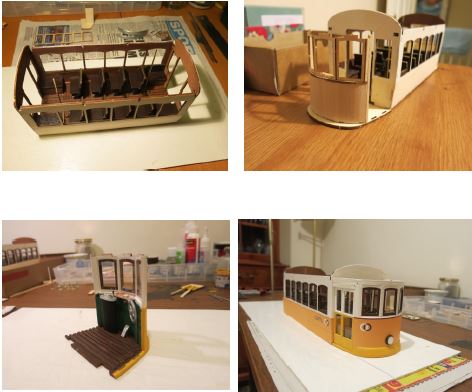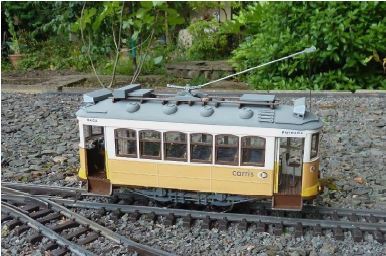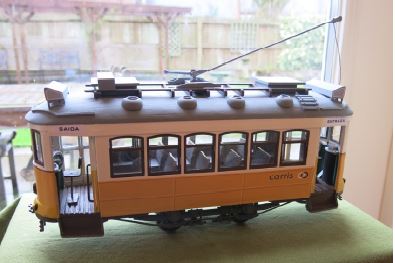Lisbon Tram - G scale 1:24
Michael Glover.
Video of test run - HERE
Video of prototype - HERE
I have modelled trains and more recently trams and tram layouts in 00 gauge for a number of years. A year ago I was looking for something different to occupy the dark winter nights. I am a member of the Tramway and Light Railway Society and the November 2014 issue had an article entitled “G or not to G that is the question”? featuring G scale’s suitability for garden rail and tramways. The internet provided various options and I purchased a kit from www.occre.com via Hobbies in the UK.

During the following months the tram roof was finally assembled together with its upper details and the trolley pole. Finally, before painting the lower chassis, wheels and safety guards were put in place.
The ASRM meeting in July 2015 was held at a members house with a garden railway .This meeting gave an opportunity to feature Lisbon G scale tram in
its intended setting.


History of the Lisbon Tram.
This tram was originally part of the 701/735 series, of the Compañía de Carris de Ferro de Lisboa, which built them between 1936 and 1940. These trams were considered the safest in Lisbon as they were fitted with a reinforced braking system and were used for the lines covering the most difficult routes, such as 12, 25 or 28, with ramps of up to 12%, which were also the steepest slopes in the world for simple adherence tram lines. The tram is fitted with five types of brake, pneumatic, mechanical, electric, electromagnetic with shoes and mechanical with shoes. Each tram was also
fitted with two powerful, 45 HP, Metropolitan Vickers electric motors and a Brill 21-E type truck, built by Maley & Tauton. The body is of the standard Lisbon type, based on American Brill designs,
with its most notable characteristic being the sharply cambered roof. The tram maintained its original design up until 1985-1987, when the series was reformed and adapted for a single driver/conductor, pneumatically operated doors were installed along with flashing lights and the street-side doors were sealed off.
After 1995 the original trams gradually started to be replaced with remodelled Series 500 trams, although a number of units were maintained in operational conditions for charter services and occasional substitutions on the regular lines.